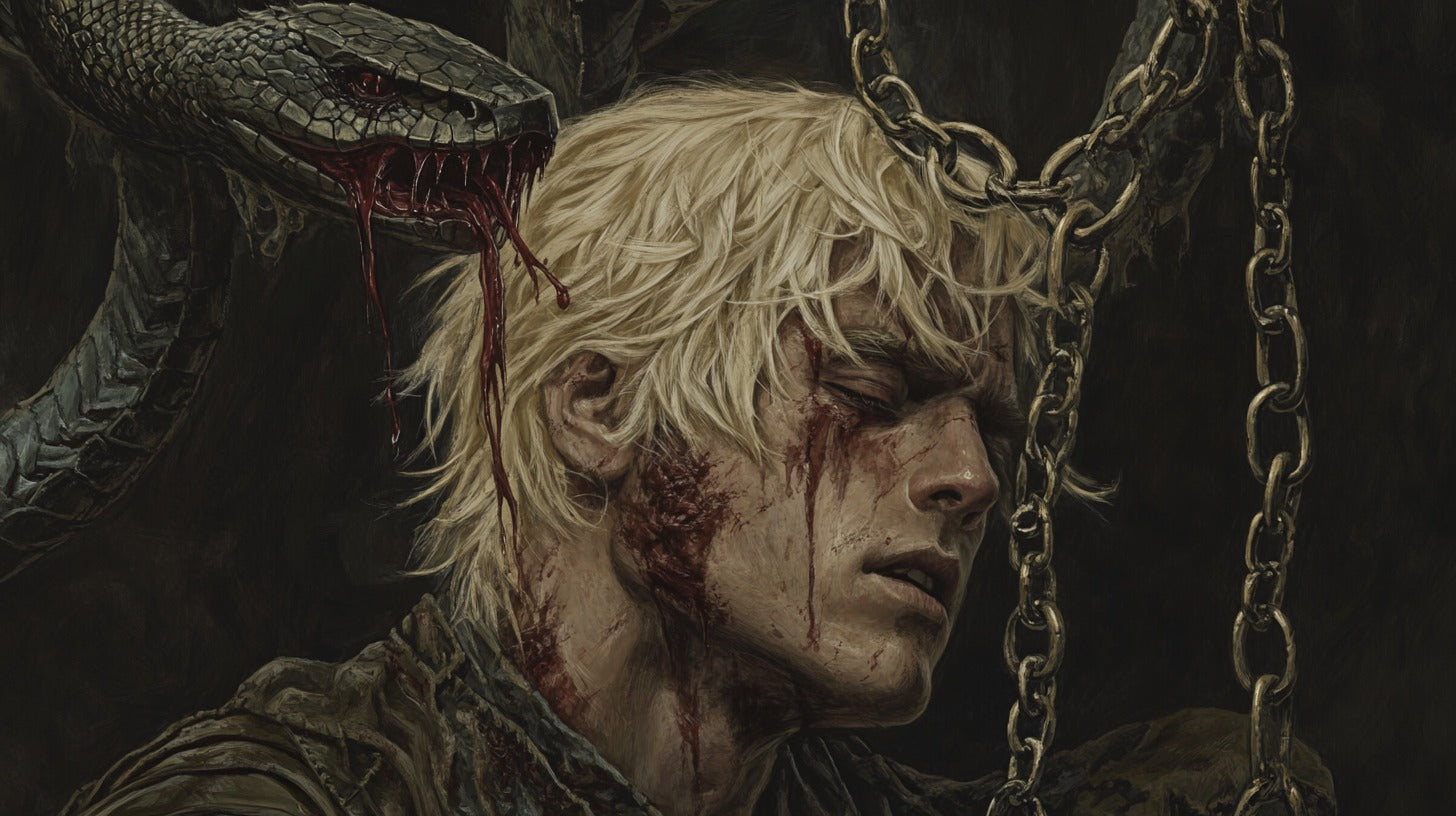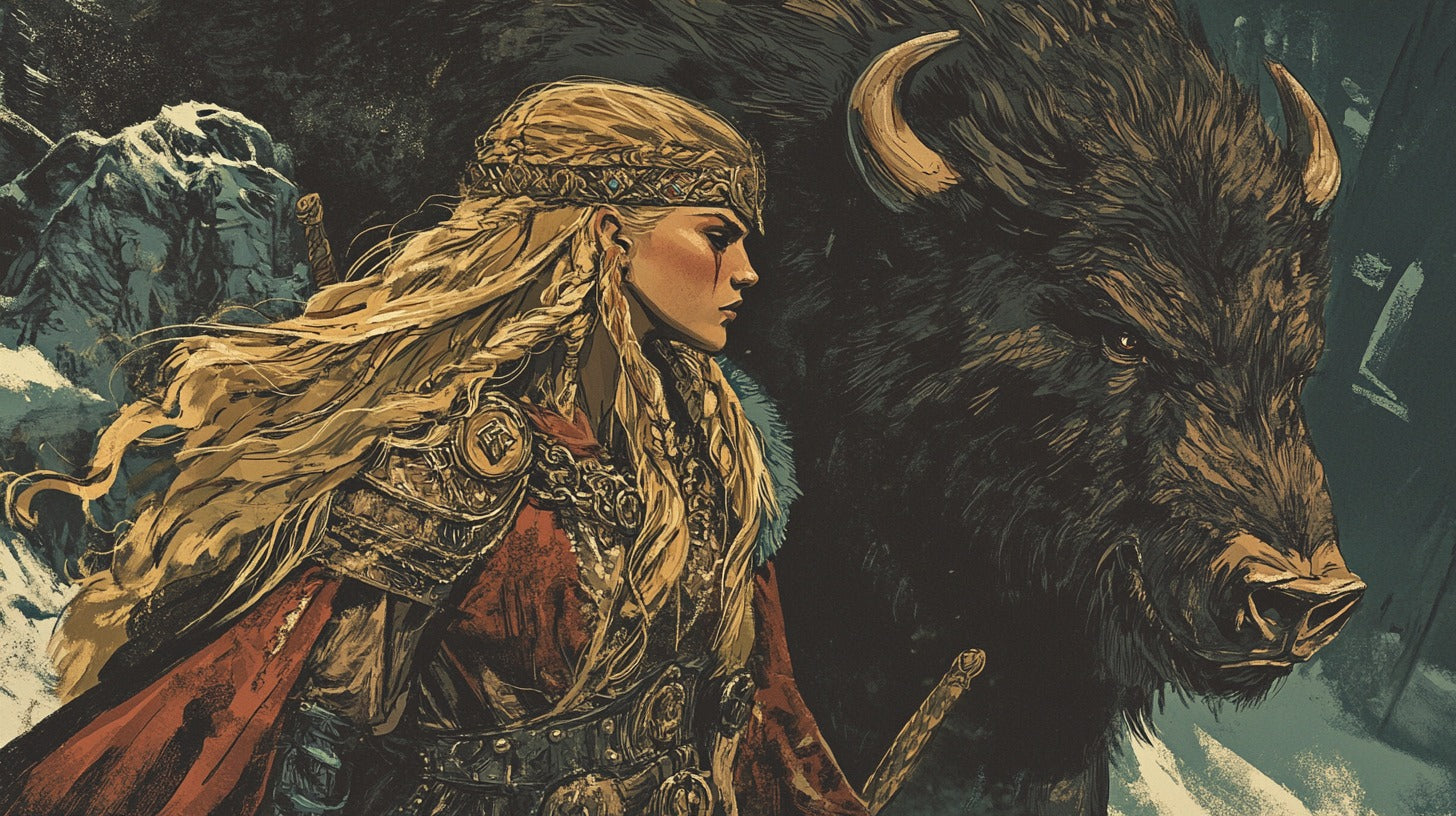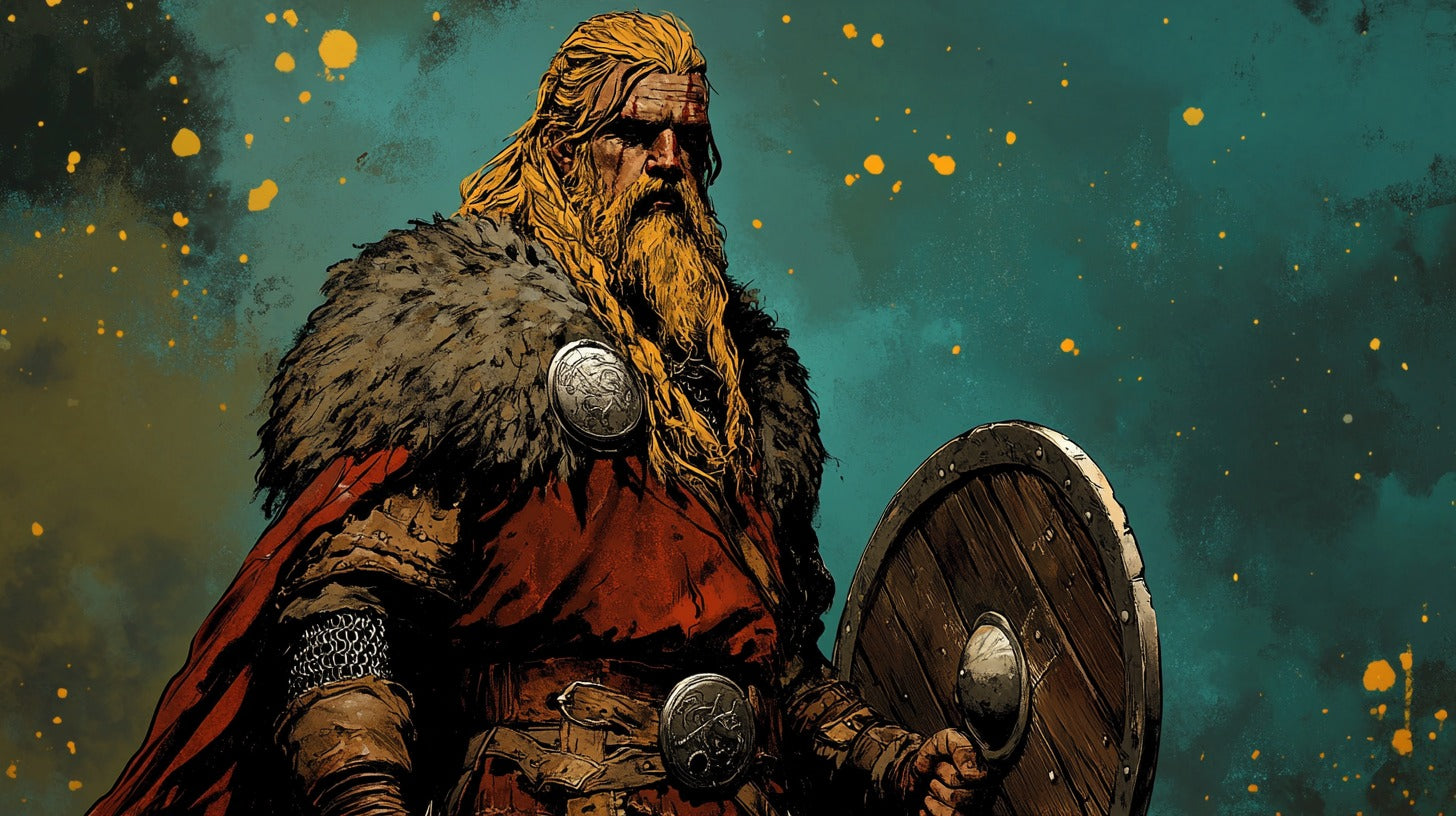
Thor: Hammer of the Gods and Guardian of Midgard
The clash of hammer against anvil, the roar of thunder across stormy skies - these are the sounds that herald the coming of Thor, mightiest of the Aesir gods. But who is this red-bearded deity that has captured the imagination of people for centuries? Is he merely a brutish warrior, or is there more to the God of Thunder than meets the eye? From the mead halls of ancient Scandinavia to the silver screens of Hollywood, Thor's influence has echoed through the ages. Today, we'll peel back the veil of myth and legend to reveal the complex, fascinating figure at the heart of some of Norse mythology's greatest tales.
Origins and Family

The Sønder Kirkeby Runestone (DR 220), its inscription translating too "May Thor hallow these runes!", located in Denmark / Photo: Bloodofox, CC BY-SA 3.0
Odin and Jord: Thor's Divine Parents
Thor's lineage is as impressive as his mighty deeds. Born of the union between Odin, the Allfather and king of the Aesir gods, and Jord, the personification of Earth herself, Thor's very existence bridges the gap between the celestial and the terrestrial. This dual heritage imbues him with both divine authority and a deep connection to the world of mortals.
Siblings and Relationships
While Thor may be the most renowned of Odin's offspring, he is far from alone in the divine family tree. His half-brothers include the blind god Hodr and the silent Vidar, each with their own unique roles in the cosmic drama. Thor's relationship with Loki, the trickster god and Odin's blood brother, is particularly noteworthy, oscillating between camaraderie and conflict with all the unpredictability of a summer storm.
Thor's own family life is no less complex. His wife, the golden-haired Sif, is a goddess associated with fertility and the earth. Their union has produced two sons, Modi and Magni, whose names mean "Wrath" and "Mighty" respectively – fitting monikers for the children of the thunder god.
Thor's Iconic Attributes
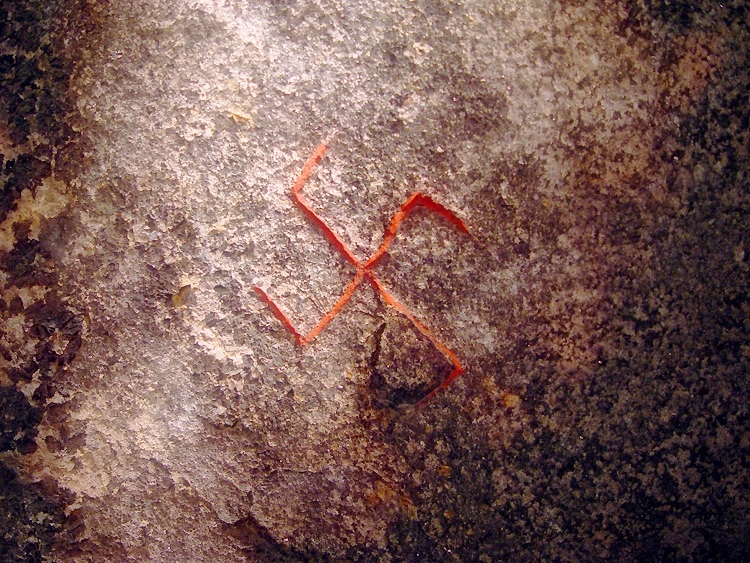
Detail of a swastika on the 9th century Snoldelev Stone, a symbol representing Thor's lightning during the Viking Age / Photo: Bloodofox
Mjolnir: The Legendary Hammer
No discussion of Thor would be complete without mention of his most famous possession: the hammer Mjolnir. Forged by the dwarven brothers Brokkr and Sindri, this short-handled weapon is more than just a tool of destruction. It is a symbol of Thor's power, a talisman of protection, and an instrument of consecration.
Mjolnir's abilities are as varied as they are impressive. It never misses its target and always returns to Thor's hand, like a loyal hound heeding its master's call. The hammer can shrink to fit in Thor's shirt, yet grow to enormous size when wielded in battle. Its thunderous impact can level mountains and its mere presence can resurrect the dead – at least when it comes to Thor's goats.
Thor's Chariot and Goats
While Thor is often depicted striding across the heavens, he also travels in style when the occasion demands. His chariot, pulled by two magical goats, races across the sky with a thunderous rumble that mortals mistake for storms.

Thor's Goats - Tanngrisnir & Tanngnjóstr Arm Ring
Tanngrisnir and Tanngnjóstr
These are no ordinary goats. Named Tanngrisnir (Gap-Tooth) and Tanngnjóstr (Tooth-Grinder), these beasts possess a remarkable ability. Should Thor find himself in need of sustenance during his travels, he can slaughter and eat his goats, knowing that they will be restored to life the next day – provided their bones remain unbroken.
Thor's Role in Norse Cosmology

Midgard, home of the humans / Image: Paganheim
Protector of Midgard
In the grand scheme of Norse cosmology, Thor stands as the stalwart defender of Midgard, the realm of humans. His strength and courage form a bulwark against the chaotic forces that threaten the cosmic order. When thunder rolls across the sky, the Norse people took comfort in knowing that Thor was battling the enemies of gods and men alike.
Enemy of the Jötnar
Chief among these enemies are the Jötnar, often translated as "giants" but perhaps better understood as primordial nature spirits. These beings, embodying the harsh and untamed aspects of the world, find themselves constantly at odds with Thor. His battles against them are not merely tests of strength, but symbolic conflicts between order and chaos, civilization and wilderness.
Famous Myths and Adventures
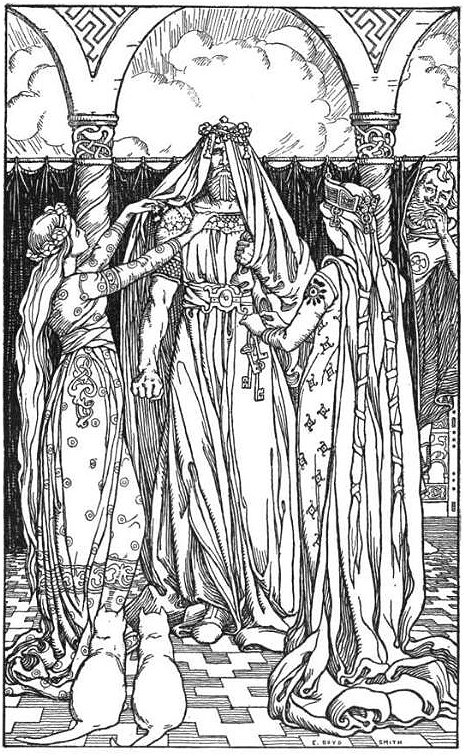
Thor is unhappily dressed by the goddess Freyja and her attendants as herself / Photo: Elmer Boyd Smith (1902)
The Theft of Mjolnir
One of the most beloved tales featuring Thor revolves around the theft of his precious hammer. In this story, Thor awakens to find Mjolnir missing, stolen by the cunning giant Thrym. The price for its return? The hand of the beautiful goddess Freyja in marriage.
What follows is a comedic escapade worthy of the finest storytellers. Thor, disguised as Freyja in a bridal gown, travels to Jötunheim with Loki as his handmaiden. The ensuing feast is a masterclass in tension and humor, as Thor struggles to maintain his disguise despite his prodigious appetite and fierce demeanor.
Thor's Journey to Útgarða-Loki
Another famous tale takes Thor and his companions on a journey to the castle of Útgarða-Loki, a powerful giant king. Here, Thor faces a series of seemingly impossible challenges that test not only his strength but his very understanding of reality.
From wrestling with an old woman who turns out to be Old Age itself, to attempting to drain a drinking horn connected to the sea, Thor's adventures in Útgarða-Loki's realm are a poignant reminder that even the mightiest can be humbled by the clever manipulations of others.

The Fishing Trip with Hymir
Perhaps no tale better illustrates Thor's role as a protector of cosmic order than his fishing trip with the giant Hymir. In this myth, Thor hooks none other than Jörmungandr, the Midgard Serpent, whose colossal body encircles the earth.
The battle between Thor and the serpent is epic in scale, threatening the very fabric of reality. In the end, Hymir, fearing for the world's safety, cuts the fishing line, allowing Jörmungandr to sink back into the depths. This encounter foreshadows Ragnarök, the prophesied end of the world, where Thor and Jörmungandr are destined to slay each other.
Thor in Norse Religious Practices

The Christian Boniface destroys Donar's (Thor's) oak, a sacred tree once located in Henesse, Germany / illustration: Charles Robinson
Worship and Rituals
Thor's popularity among the Norse people cannot be overstated. As a god of the common folk, he was widely worshipped throughout Scandinavia. Farmers prayed to him for good harvests, sailors for safe voyages, and warriors for strength in battle.
Rituals dedicated to Thor often involved the sacrifice of goats, echoing the story of his own magical animals. The hammer symbol, a representation of Mjolnir, was widely used as a protective amulet, worn around the neck or carved into doorposts to ward off evil.
Thor's Influence on Place Names
The importance of Thor in Norse culture is reflected in the numerous place names that bear his mark. From Thorsby in England to Torshavn in the Faroe Islands, the thunder god's name echoes across the landscape of Northern Europe, a testament to his enduring influence.
Thor's Legacy in Modern Culture

Thor issues blows to the sleeping Skrýmir while the group looks on / Illustration: Friedrich Ludwig von Maydell (1842)
Literature and Art
Thor's influence extends far beyond the realms of ancient myth. In literature, he has inspired countless works, from the epic poems of the Viking Age to modern fantasy novels. Artists throughout history have sought to capture his likeness, from ancient runestones to Renaissance paintings to contemporary comic books.
Popular Media and Entertainment
In recent years, Thor has experienced a resurgence in popularity thanks to his portrayal in Marvel comics and the subsequent film adaptations. While these modern interpretations often take liberties with the original myths, they have introduced Thor to a new generation of admirers, sparking renewed interest in Norse mythology as a whole.
Conclusion: The Enduring Appeal of Thor
As we've journeyed through the realms of Norse mythology, we've seen that Thor is far more than just a god of thunder. He is a protector, a hero, and a symbol of the enduring human spirit in the face of cosmic forces beyond our control. From the mead halls of ancient Scandinavia to the silver screens of today, Thor continues to capture our imagination with his strength, his flaws, and his unwavering commitment to the protection of both gods and mortals.
In a world that often feels chaotic and unpredictable, perhaps we find comfort in the idea of a divine protector, wielding the power of the storm to keep chaos at bay. Or perhaps we simply enjoy the timeless tales of a red-bearded god who's as likely to outsmart his enemies as he is to smash them with his hammer.
Whatever the reason, one thing is clear: as long as thunder rolls across the sky, the legend of Thor will continue to resonate in our hearts and minds, a reminder of the power of myth to shape our understanding of the world and our place within it.
FAQs
- Was Thor always depicted with red hair?
While the red-haired image is popular today, ancient sources vary in their descriptions. Some depict Thor with red hair, while others describe him as fair-haired or even dark-haired.
- Could anyone else lift Mjolnir in Norse mythology?
Unlike in modern adaptations, Mjolnir in Norse mythology didn't have a worthiness enchantment. Its weight and Thor's strength made it difficult for others to wield, but it wasn't impossible.
- Did Thor have any children besides Modi and Magni?
Some sources also mention a daughter named Thrúd, though less is known about her compared to Thor's sons.
- Was Thor worshipped outside of Scandinavia?
Yes, Thor was also worshipped by Germanic peoples on the continent and by Norse settlers in places like Iceland, the British Isles, and even parts of North America.
- How did Thor's role in Norse mythology differ from Zeus in Greek mythology?
While both were associated with thunder, Thor was more directly involved with humanity as a protector. He was also not the king of the gods like Zeus, with that role belonging to Odin in Norse mythology.
References
Sturluson, S. (13th century). The Prose Edda. Iceland.
Anonymous. (13th century). The Poetic Edda. Iceland.
Ellis Davidson, H.R. (1964). Gods and Myths of Northern Europe. Penguin Books.
Lindow, J. (2001). Norse Mythology: A Guide to the Gods, Heroes, Rituals, and Beliefs. Oxford University Press.
Crossley-Holland, K. (1980). The Norse Myths. Pantheon Books.
